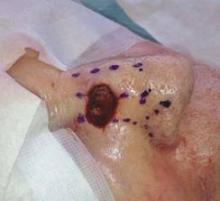SAN DIEGO – Before he proceeds to close a wound following Mohs surgery, Dr. Howard Steinman employs the mnemonic CAT-STARTS to help him select the repair.
A modification of STARTS, Dr. Steinman uses CAT-STARTS to represent the following factors he considers prior to carrying out the repair: first assess the Cosmetic units, Areas of available skin, and Textures of available skin. Then consider closure options: Second intention and Simple (linear) repairs, Transposition flaps, Advancement flaps, Rotation flaps, Tissue interpolation flaps, and Skin grafts.
"Prior to closing, I draw in the surrounding cosmetic units of the face. Once you’ve done that, you should pay attention to the relaxed skin tension lines," Dr. Steinman said at a meeting sponsored by the American Society for Mohs Surgery.
To illustrate, he showed attendees a digital image of a patient’s nasal lesion prior to repair. "I draw in the midline, the side of the nasal dorsum and nasal-jugal lines, and the alar fold," he explained. "Then I look at the skin texture. This case had a mix of sebaceous skin and smooth skin, so I factored that consideration in to my repair."
Candidate wounds for second-intention healing "are small, shallow wounds, usually less than 1 cm in diameter," said Dr. Steinman, who practices dermatology and Mohs surgery in Irving, Tex. "They’re usually less than a half centimeter deep. Second-intention healing is often especially effective for the alar fold and the medial canthus and less effective for the cheeks, chin, and around the lips."
If healing by second intention is not an option, "you want to consider your repair choices, from the simplest to the most complex," he said. Thus, consider simple (linear) repairs. Thereafter, his suggested order of complexity begins with transposition flaps, followed by advancement flaps, rotation flaps, tissue interpolation flaps, and skin grafts.
"The midline of the nose and the midline of the forehead are two of the best places to do linear repairs, as is the cheek and forehead," Dr. Steinman commented. "One thing to remember about straight line repairs is that they cause significant secondary motion perpendicular to the axis of closure. You need to respect that when doing linear repairs near free margins," he added.
If you unable to close a wound in a side-to-side fashion, "a transition flap may be your best option," he continued. "Because rotation flaps require longer, broad incisions, in my view you should often think about an advancement flap as your next choice after transposition flaps in terms of complexity."
Tissue interpolation flaps are reserved "for instances where no local skin flap is a better choice," he said. "The midline forehead flap is excellent for distal nasal defects because you have a broad area of skin and it’s based on a vascular pedicle. Interpolation flaps are two-stage procedures."
He views skin grafts to be a last choice for most wound repairs. "If you do them well and, when needed, laser or abrade them, they often look acceptable, but in my opinion they are the last option for many locations," he said.
Dr. Steinman said that he had no relevant financial conflicts to disclose.


